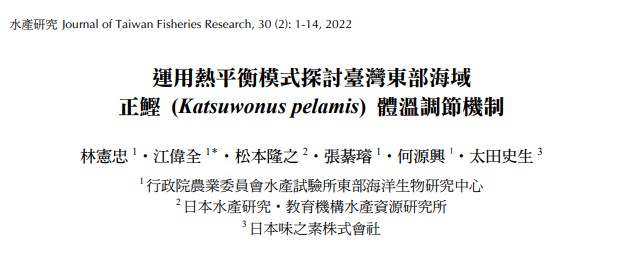運用熱平衡模式探討臺灣東部海域 正鰹 (Katsuwonus pelamis) 體溫調節機制

正鰹 (Katsuwonus pelamis) 為大洋高度洄游性魚種,廣泛分布於熱帶及溫帶海域。本研究於臺灣東部綠島海域利用記錄型標識器解析正鰹移動行為的體溫調節機制。總計回收5尾正鰹的記錄器資料,分析結果顯示,其下潛行為棲息深度介於0–310 m,環境溫度介於13.1–28.3℃,腹腔內溫度則介於17–28.2℃,具有晝夜週期性的下潛行為模式。經由熱平衡模式分析正鰹生理和體溫調節的行為,顯示腹腔內溫度皆高於棲息環境水溫,尤其於白天進行下潛行為時更加明顯。當正鰹棲息於表層時,平均傳熱係數為2.7 ± 0.6 (10-3/s),而下潛時,平均傳熱係數為0.9 ± 0.3 (10-3/s),表示下潛時體內溫度下降緩慢。當下潛至混合層以深之水層時,雖然環境溫度隨深度迅速下降,而腹腔內溫度變化於下潛後,以約7分鐘的速率緩慢下降。根據環境溫度資料,經由熱平衡模式計算腹腔內溫度的估計,顯示熱平衡之溫度與實際測量之溫度結果吻合。本研究結果顯示,正鰹經由生理機制改變傳熱速率進行體溫的調節,這種機制相似於鮪類物種,能夠穿越溫躍層或較低溫之水層,擴增巡游範圍以利尋找或利用更廣泛之餌料生物資源。
The skipjack tuna (Katsuwonus pelamis) is a highly migratory pelagic species that is abundant in tropical and temperate seas. In this study, skipjack tuna marked with archival tags were released near Green Island in southeastern Taiwan in order to examine changes in their body temperature as they moved through their natural environments. Five fish were recovered, depths occupied ranged from 0 to 310 meters, ambient temperature ranged from 13.1℃ to 28.3℃ and peritoneal cavity temperature ranged from 17.0℃ to 28.2℃, and diving patterns correlated with diurnal cycles. The heat budget model revealed physiological and behavioral thermoregulation in which peritoneal temperatures were maintained above ambient; this was particularly evident during daytime deeper dives. As skipjack tuna ascends to the surface, the average heat-transfer coefficient is 2.7 ± 0.6 (10-3/s), whereas when they return, the average heat-transfer coefficient is 0.9 ± 0.3 (10-3/s), indicating that body heat is retained. When fish dives below the mixed layer depth, the ambient temperature drops rapidly with the depth, while peritoneal cavity temperature descent slowly at a rate of about 7 minutes after the dive. Using our model, we were able to estimate peritoneal temperatures based on the ambient water temperature. According to our findings, skipjack bonito regulates thermoregulation by altering heat transfer coefficients via a physiological mechanism. This mechanism and behavior are comparable to those of species of Thunnus. In conclusion, skipjack tuna can cross the thermocline or expand its cruising range in cooler water in order to find or utilize additional resources more broadly.